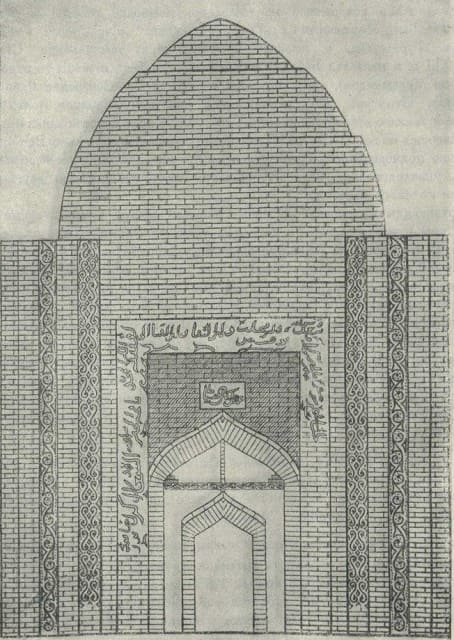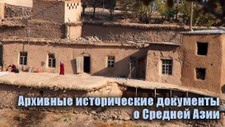You are here
Mausoleum Sarlytam on Zhanadarya.

Tours in Kyzylorda region.
"... inexperienced life hid with goodness at the beginning of Safar in the year 698. And the spirit gave up for the sake of departure from the receptacle of corruption to the abode of eternity, the chaste power, honest, the beginning of good deeds, the embryo of well-being Kizl khatun, daughter...".
Inscription above the entrance portal of the Sarlitam mausoleum.
Silk Road Tour in Kyzylorda region.
Sarlytam mausoleum is located on right bank of drying up channel of Zhanadarya, in Kyzylkum desert, 20 kilometers south-west of Chirik-rabat settlement, 41 kilometers from state border with Republic of Uzbekistan and 12.3 kilometers to east and slightly north of Kekireli village in Karmakshy district of Kyzylorda region.
Syrlytam (Sarly-tam) is a Khorezm mausoleum, an architectural monument of Kazakhstan, according to one version of the VIIth - VIIIth centuries, according to another, the XIth - XIVth centuries. The architect of the mausoleum is unknown.
In the Sarlytam (Zhanadarya) mausoleum of the XIVth century, the pylons of the portal are finished with wedge-shaped facing bricks and are connected by a half-pole on cellular trumpets. The portal arch is lined with alternating ordinary facing and glazed bricks. Above it is an ornamented majolica strip.
Syrlytam is a single-chamber portal-domed structure built of baked bricks. In plan it measures 9.85 × 10.20 meters, the preserved height of the building is 9 meters. The transition from the four to the eight is carried out using corner arches.
Then, with the help of diagonally protruding bricks-consoles in the corners of the octagon, the transition was made directly to the circle of the dome. The double dome with a sixteen-sided drum has not survived. The mausoleum has two entrances - from the south from the north.
The central entrance (on the south side) was decorated with a portal with a pointed arch. The pestak of the main facade is decorated with a U-shaped belt made of majolica tiles. The false-vaulted drum windows have a lancet shape.
The portal facade significantly exceeds the height of other facades and is really a portal stretched across the entire width of the building. Its upper parts are destroyed, but simple calculations show that the original height should have been more than 7 meters.
The interior architecture of the mausoleum makes an unusual impression by combining traditional ancient techniques - perspective-stepped trumpets, a large hatch at the zenith of the dome - and the context in which they are inscribed.
The plan of the mausoleum to the Syrlyts is subordinated, as elsewhere in Central Asia, to a metric grid with a unit - gyaz measuring 70.5 cm. 10 gyaz are the sides of the room, 2 gyaz are the thickness of the walls (except for the portal) and the width of the entrance, 4 gyaz are the width of the portal niche, - sure.
This mausoleum is one of “that special group of Central Asian mausoleums, which are characterized by the presence of a hipped-roof dome raised on a drum, evidence of painstaking architectural searches of the Northern Turkestan builders.
Syrlytam is unique, since there are very few mausoleums of the Golden Horde time with surviving, uncollapsed domes and drums, and those monuments where at least the remains of these structures have survived sufficiently to judge their original appearance are of particular value.
On the territory of Kazakhstan there is another mausoleum dating back to this period, it is located 25 km south of the village of Inkardarya, on the bank of the dry channel of the channel of the same name. In terms of their architectural features, these mausoleums are very similar, both are single-chamber portal-domed structures, and their fundamental difference from each other lies only in the structures of the domed ceiling.
The historical and cultural significance of the two surviving Golden Horde mausoleums of the Eastern Aral Sea region is enhanced by the fact that, due to the high degree of preservation, they give a fairly complete picture of the two main types of mausoleums of the nobility of this period.
It is noteworthy that located at a considerable distance from each other, both of them have the same name - Syrlytam. The Kazakh archaeologist MK Sembin, analyzing the meaning of some of the most common names of architectural monuments, wrote:
“With decorative painting in the interior, carved terracotta in the facing of facades, one should associate, in particular, the Syrlyts (syrly - painted, painted). There are several mausoleums with this name in Kazakhstan and they are located in different regions of the country (Akmola, Kostanay, Kyzylorda regions)."
Common names, as a rule, appear at mausoleums that have lost their own name, that is, in cases where history has not preserved the names of those who are buried in them to this day. Time and human activity does not spare ancient monuments, unfortunately this also applies to the Syrlyt mausoleum on Inkardarya.
In the middle of the XXth century, the mausoleum was partially destroyed. According to local old-timers, the roof of the mausoleum was accidentally demolished with a rope by the tractor drivers of the Uzbektorg saxaul harvesting enterprise.
However, the walls remained unharmed.
In the early 2000s, the historical and cultural monument was reconstructed. After restoration Syrlytam regained its original appearance. In 1982, the Syrlytam mausoleum was included in the list of historical and cultural monuments of the Kazakh SSR of republican significance and was taken under state protection.
Here is how S.P. Tolstov in his book "In footsteps of ancient Khorezm civilization" in 1948.
“On October 9, at 09:38 am, we will take off for the second flight (during our flights, the mobile base should move 100 km to the east, to the area of the Kum-Kala ruins). We fly west. We pass over the grandiose mausoleum of Sarly-tam, abandoned in a thick bowl of saxaul trees. We are going down.
With a low-level flight, we make several circles over the mausoleum at an altitude of 30 - 40 meters above the ground. Landing is not possible. Before us is a magnificent domed building, with a high portal trimmed with turquoise majolica, not inferior to the mazars of Kunya-Urgench and clearly related to the XII - XIII centuries. n. e. a thick saxaul forest saved the mausoleum from being dismantled by practical "Muslim" -Kazakhs, who take little regard with the old Muslim shrines when they need burnt bricks for their ancestral cemeteries.
We'll have to, apparently, on the way back to break through the thicket of saxaul to get to the mazar and measure it. We return to the northeast. Below us is an endless panorama of a variety of late medieval
rrigation structures and fortifications. We return to Chirik-rabat at 12 o'clock."
From book Epigraphy of East III. 1949. Article by M.E. Masson "Time and history of construction of "Gumbez Manas".
"The dating of the "Gumbez Manas" can also be clarified by an analysis of the titles or rather the set of honorary nicknames of the persons mentioned in the inscription, given that the combination of such nicknames in epitaphs is more or less standard for each individual historical era.
In this regard, the inscription of the Kyzyl-Kum mausoleum Syrlytam (which means "Polished tomb"), which has remained completely unread by anyone, is of great interest. A schematic drawing of the main facade made from it in 1900 by Tyulekbergen Dzhilkibaev on the instructions of V. A. Kallaur was published in the minutes of the Turkestan Circle of Archaeology Lovers, and N. P. Ostroumov saw the date 678 - 1279 in the inscription.
The beginning and end of the inscription, which runs in the form of a frame for the entrance niche along the entire portal, as in the "Gumbez Manas", are largely lost. In the surviving part of the text we read the following: "... inexperienced life disappeared with goodness at the beginning of Safar in the year 698.
And the spirit gave up for the sake of departure from the receptacle of corruption to the abode of eternity, chaste strength, honest, the beginning of good deeds, the embryo of well-being Kizl khatun, daughter ...". In a separate panel of the gable wall of the niche, above the door, the name of the master is indicated:
"Work of Jamal Hayat. Safar 693 AH began on November 8, 1298 AD, and thus in the inscription of the mausoleum of the very end of the 13th century we have a literal coincidence of five words of honorary nicknames with those in the epitaph of Kanyzyak khatun.
Geographic coordinates of Sarlytam mazar near Zhanadarya river channel: N43°56'25 E62°44'33
Authority:
Alexander Petrov. S.P. Tolstov. "In the footsteps of the ancient Khorezm civilization." 1948.
https://culturemap.kz/







